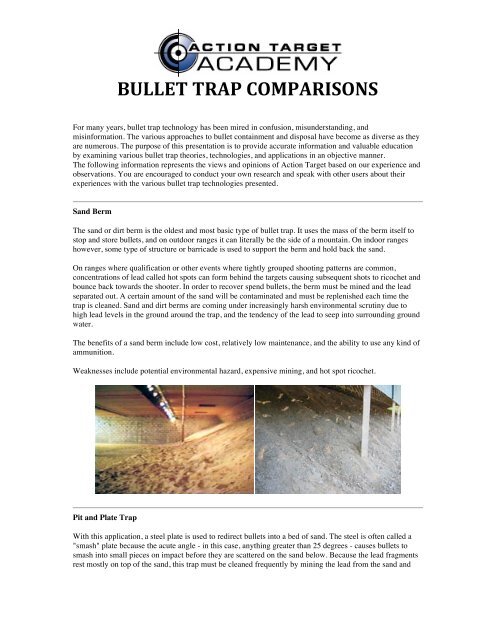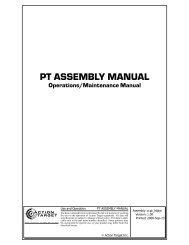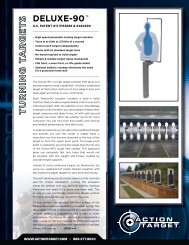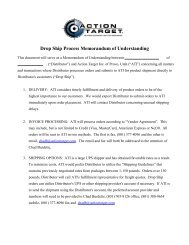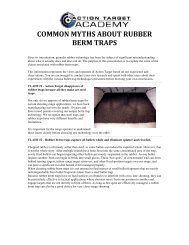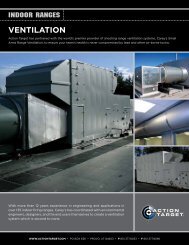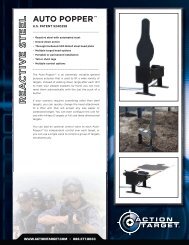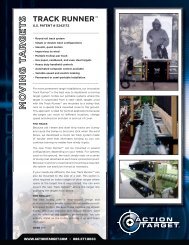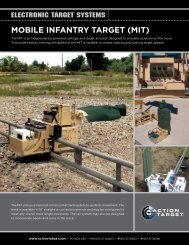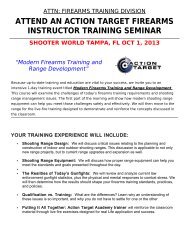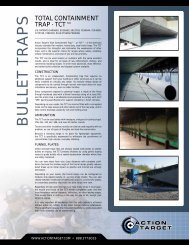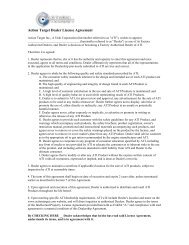BULLET TRAP COMPARISONS - Action Target
BULLET TRAP COMPARISONS - Action Target
BULLET TRAP COMPARISONS - Action Target
Create successful ePaper yourself
Turn your PDF publications into a flip-book with our unique Google optimized e-Paper software.
<br />
<strong>BULLET</strong> <strong>TRAP</strong> <strong>COMPARISONS</strong> <br />
<br />
For many years, bullet trap technology has been mired in confusion, misunderstanding, and<br />
misinformation. The various approaches to bullet containment and disposal have become as diverse as they<br />
are numerous. The purpose of this presentation is to provide accurate information and valuable education<br />
by examining various bullet trap theories, technologies, and applications in an objective manner.<br />
The following information represents the views and opinions of <strong>Action</strong> <strong>Target</strong> based on our experience and<br />
observations. You are encouraged to conduct your own research and speak with other users about their<br />
experiences with the various bullet trap technologies presented.<br />
Sand Berm<br />
The sand or dirt berm is the oldest and most basic type of bullet trap. It uses the mass of the berm itself to<br />
stop and store bullets, and on outdoor ranges it can literally be the side of a mountain. On indoor ranges<br />
however, some type of structure or barricade is used to support the berm and hold back the sand.<br />
On ranges where qualification or other events where tightly grouped shooting patterns are common,<br />
concentrations of lead called hot spots can form behind the targets causing subsequent shots to ricochet and<br />
bounce back towards the shooter. In order to recover spend bullets, the berm must be mined and the lead<br />
separated out. A certain amount of the sand will be contaminated and must be replenished each time the<br />
trap is cleaned. Sand and dirt berms are coming under increasingly harsh environmental scrutiny due to<br />
high lead levels in the ground around the trap, and the tendency of the lead to seep into surrounding ground<br />
water.<br />
The benefits of a sand berm include low cost, relatively low maintenance, and the ability to use any kind of<br />
ammunition.<br />
Weaknesses include potential environmental hazard, expensive mining, and hot spot ricochet.<br />
Pit and Plate Trap<br />
With this application, a steel plate is used to redirect bullets into a bed of sand. The steel is often called a<br />
"smash" plate because the acute angle - in this case, anything greater than 25 degrees - causes bullets to<br />
smash into small pieces on impact before they are scattered on the sand below. Because the lead fragments<br />
rest mostly on top of the sand, this trap must be cleaned frequently by mining the lead from the sand and
<br />
disposing of it properly. Under moderate to heavy use, a thick lead build-up can develop in the back corner<br />
of the trap causing bullets to be deflected back towards the shooter.<br />
The benefits of a pit and plate trap include lower initial cost and simple installation.<br />
Weaknesses include bullet fragmentation on impact, lead build-up, ricochet, and high maintenance.<br />
Water and Plate Trap<br />
The water and plate trap is similar to the pit and plate trap, except the sand is replaced by a large trough of<br />
water. Bullets still fragment into small pieces after impacting the smash plate, but now they splash into the<br />
water and sink to the bottom of the trough. To retrieve the lead, you must shovel or scoop it from the water<br />
and dispose of it properly. The water in the trough must be replenished due to evaporation, and the<br />
evaporation can cause increased humidity on your range and problems with your ventilation system.<br />
The benefits of a water and plate trap include lower lead dust levels and no ricochet off other bullets.<br />
Weaknesses include bullet fragmentation on impact, maintenance of the water, and the limitation to indoor<br />
use only.<br />
Venetian Blind Trap<br />
This older application uses a series of angled steel smash plates to redirect bullets to the back and bottom of<br />
the trap. Some versions of this trap have the smash plates mounted loosely to help absorb some of the<br />
bullets' energy, but the acute angle of the plates can still cause significant fragmentation.
<br />
To keep bullet splatter from bouncing back at the shooter, rubber curtains are often mounted across the<br />
entire face of the trap. Because rubber is destroyed every time you shoot into it, these curtains must be<br />
replaced or patched frequently to maintain their effectiveness.<br />
The benefits of a venetian blind trap include the durability of steel, no sand or granules, and a small floor<br />
space requirement.<br />
Weaknesses include bullet fragmentation on impact, splatter & ricochet, no close-range shooting, and<br />
maintenance of the rubber curtains.<br />
Escalator Trap<br />
This is another old-fashioned steel trap that uses steeply angled smash plates to stop bullets and direct the<br />
fragments to an open collection area.<br />
Some manufacturers recommend that the impact plates be coated with oil to provide lubrication and reduce<br />
fragmentation. This oil can be washed away into the surrounding soil if the trap is not protected from the<br />
elements in outdoor applications.<br />
The same system of protective rubber curtains may also be necessary with this trap due to the acute angle<br />
of its steel smash plates.<br />
The benefits of an escalator trap include the durability of steel and no sand or rubber granules.<br />
Weaknesses include bullet fragmentation on impact, no close-range shooting, maintenance of the rubber<br />
curtains, and poor lead storage and collection.
<br />
Rubber Lamella Trap<br />
With this trap, tightly grouped rubber curtains or lamellas are hung from a support structure to create a<br />
bullet stopping barrier. As bullets pass through the layers of rubber strips, their energy is dissipated until<br />
they come to a stop. A steel plate is mounted at the back of the trap to block rounds that make it through the<br />
lamellas. Because rubber is destroyed every time you shoot into it, the rubber strips are quickly shredded<br />
under any kind of moderate to heavy use. One of the most quoted features of rubber traps is that bullets<br />
don't fragment on impact like they do on steel. This is true until bullets start impacting other bullets already<br />
embedded in the rubber. Regardless of the application, the use of a rubber bullet trap introduces a very real<br />
fire hazard that must be considered and dealt with appropriately<br />
The benefits of a lamella trap include its small floor space requirement, and the ability to capture some<br />
bullets whole.<br />
Weaknesses include high maintenance costs, fire hazard, messy appearance, and the restriction of low<br />
volume shooting only.<br />
Vertical Rubber Granule Trap<br />
Another European design uses a large steel chamber filled with chopped rubber and a penetrable rubber<br />
sheet across the front the keep the rubber granules in place.<br />
The trap works the same way a sand berm works, except the sand is replaced by granules of chopped<br />
rubber and the face of the trap is vertical. Like the rubber lamella trap, the front skin of the rubber granule<br />
trap is permanently damaged each time a bullet is fired into it.<br />
As larger and larger holes are created in the front skin, rubber granules can spill out and large bulges can<br />
develop as the structural integrity of the trap is compromised. Regular patching and repair is often required<br />
to keep the granules in the chamber.<br />
As the granules settle, areas of dangerously low density can form at the top of the trap causing rounds to<br />
pass through the rubber and escape out the back. To clean the trap, bullets must be mined and separated<br />
from the rubber then disposed of properly.<br />
The benefits of a vertical rubber granule trap include its small floor space requirement, the ability to<br />
capture some bullets whole, and reduced lead dust levels.<br />
Weaknesses include massive ongoing maintenance, service costs, fire hazard, and the restriction of low<br />
volume shooting only.
<br />
Rubber Block Trap<br />
The rubber block trap is similar in concept to the rubber granule trap, except the rubber granules are<br />
molded together with a latex glue to form a solid object. The rubber blocks are then stacked on top of each<br />
other to create a wall that serves as the bullet trap. When a bullet is fired into the blocks, it is stopped and<br />
stored within the block itself. Like all rubber traps, the blocks are damaged with every shot and large holes<br />
quickly develop, severely limiting the trap's ability to stop bullets. As the holes get larger, the blocks get<br />
weaker and the whole wall tends to collapse under its own weight.<br />
The benefits of a rubber block trap include its small floor space requirement and the ability to capture some<br />
bullets whole.<br />
Weaknesses include UV breakdown, significant ongoing maintenance, fire hazard, and structural collapse.<br />
Wet Funnel Trap<br />
The wet funnel trap incorporates gently sloping steel plates that reduce bullet fragmentation on impact. As<br />
bullets hit the plates, they are directed to the narrow end of the funnel and enter a deceleration chamber<br />
where their energy is dissipated.<br />
While the upper impact plates remain dry, the lower plates are constantly flooded with a water and oil<br />
mixture that is intended to lubricate the steel. The water is continually recycled as it flows down the plates<br />
and into a holding tank where it is electrically pumped out and again sprayed on to the plates.<br />
On indoor ranges, some wet trap owners report that the increased humidity can leave an oily film on the<br />
rest of the range and may cause HEPA filters in the ventilation system to clog. They have also discovered<br />
that frangible ammunition can cause problems because the powder created by disintegrating bullets mixes
<br />
with the water and hardens into a cement-like substance that requires an extremely difficult cleaning<br />
process.<br />
It has been recommended to treat the water with chlorine to prevent algae in warm climates, and antifreeze<br />
to prevent freezing in colder climates. These substances combine with the water, oil, and lead, and can<br />
create a significant hazardous waste problem.<br />
The benefits of a wet funnel trap include the durability of steel, reduced bullet fragmentation, reduced lead<br />
dust levels, and the ability to handle larger calibers.<br />
Weaknesses include its higher cost, large floor space requirement, water treatment chemicals, increased<br />
humidity, problems with frangible ammunition, maintenance of the electric pumps and filters, and its nonmodular<br />
construction.<br />
Vertical Funnel Trap<br />
Instead of a continuous horizontal funnel, this trap uses a series vertically oriented funnel boxes to gather<br />
the bullets. As with a horizontal funnel, bullets are deflected by the impact plates into a deceleration<br />
chamber at the back of the trap where they are collected and stored.<br />
The angles of the impact plates are not as severe as a venetian blind or escalator type trap, but they are<br />
more severe than other modern steel traps so bullet fragmentation on impact can still be an issue.<br />
As individual chambers are mounted next to each other, vertical edges that run from the top to the bottom<br />
of the trap are created. These edges can pose a significant ricochet hazard. Additionally, the individual<br />
chamber design prohibits any cross-lane shooting and greatly limits the flexibility and functionality of the<br />
trap as a whole.<br />
The benefits of a vertical funnel trap include the durability of steel, easier lead collection, and a smaller<br />
floor space requirement.<br />
Weaknesses include bullet fragmentation, no close-range shooting, and no cross-lane shooting.<br />


